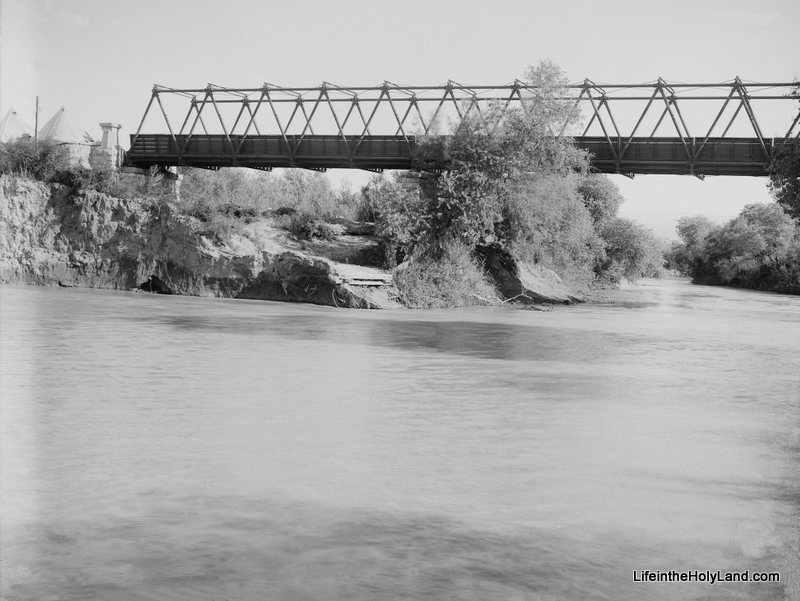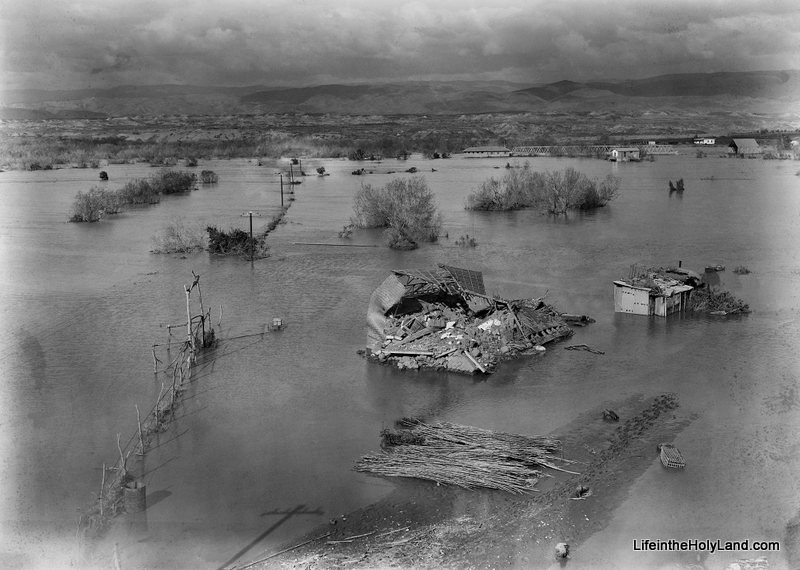(Post by Seth M. Rodriquez)
Joshua 3:15 makes the following comment in passing: “now the Jordan overflows all its banks throughout the time of harvest” (ESV). In the context of this chapter, Israel is about to cross into the Promised Land over a miraculously dry riverbed and this comment is included to give greater significance to the miracle. But before you rush to the Jordan with your camera during the next harvest season to snap a photo of this natural phenomena, let me save you some shekels by telling you that the flooding of the Jordan River is not something that happens today.
According to a 2010 report about the Jordan River (noted previously on this blog here), the Jordan River contains only 3% of the water that it did 100 years ago. According to that report, the river discharged 1.3 billion cubic meters of water in the 19th and early 20th centuries (but see a more conservative estimate in the quotation below from the Encyclopaedia Judaica). The report contrasts this with the current discharge of the river which is 20 to 30 million cubic meters. Or to put it in numerical form:
- 1,300,000,000 cubic meters per year in the past.
- 30,000,000 cubic meters per year today.
So “overflowing all its banks” is not a phrase that is typically used when describing the Jordan River today.
Fortunately, we have photographs from the first half of the 20th century that can help us illustrate this biblical phrase. Our picture of the week (and a bonus picture) come from Volume 3 of The American Colony and Eric Matson Collection which focuses on Southern Palestine. To show the contrast in the river’s levels, I have included two photos from that collection. The first photo is a picture of the newly constructed Allenby Bridge with the Jordan River flowing peacefully about 30 feet below it.
(As a side note, this is not the Allenby Bridge/King Hussein Bridge used today, but merely a forerunner of the modern bridge.)
The date of the photograph above is around 1920. The photograph below was taken in February, 1935. This was an unusually high year for the Jordan River and it “overflowed all its banks,” damaging and destroying surrounding buildings and roads.
If you look closely in the upper right section of the photo you can see the Allenby Bridge with its bottom edge touching the water. A closer view of the bridge can be seen in another photo from the collection which is posted here.
This flood year is mentioned in passing in the Encyclopaedia Judaica:
The Jordan discharges c. 875 million cu. m. into the Dead Sea a year; its yearly fluctuations are great and are caused mainly by the Yarmuk: in 1933, 287 million cu. m. and in 1935, 1,313 million cu. m.
According to this statistic, the Jordan River discharged 50% more water that year than the yearly average. There is no way of knowing how much water was discharged during the year that Joshua and the Israelites crossed, but we can be certain that the photograph above is a much better illustration of how it looked than any picture that could be taken today.
Fortunately the future of the Jordan River is looking brighter. This last summer, this blog noted a report about a plan by Israel to divert some additional water to Jordan River (see post here). Perhaps future generations will again be able to see the Jordan overflow its banks.
These photographs and over 550 others are available in Volume 3 of The American Colony and Eric Matson Collection and can be purchased here for $20 (with free shipping). Other historic images of the Jordan River can be seen here and here on LifeintheHolyLand.com, as well as a page devoted to illustrating Joshua and the Israelites “Entering the Promised Land” here.


4 thoughts on “Picture of the Week: Jordan River Flooding in 1935”
Worth mentioning:
We crossed over the Jordan River in the Month of Nisan, just before Pesach (the season of the harvest).
In a natural way, the river can flood only from an extended period of continuous rains, or augmented by the snow melt- both of these ending before Nisan.
The flooding mentioned in Joshua was not from natural causes.
Fascinating article. Thank you for taking the time to research and present it in such a beautiful way!
The author wrote an interesting article, but to understand Joshua 3:15, it has to be studied word for word in order to thoroughly understand what God was telling us, and it would take several pages of words for me to accomplish that task. So, I will attempt to briefly explain the words, so those whose hearts and minds have been circumcised to the Lord God will understand. First, you should know that the word Joshua in Hebrew means "Jehovah frees/saves" or provides us with "salvation/freedom", just as Jesus in Greek means the exact same thing, and if you don't understand, either get a good concordance/dictionary or an interlinear version of Scripture with the words correlated to the numbers, but don't get depressed about words not defined, because that is precisely why Jesus left us a "Comforter", which is the "Holy Spirit" (John 14:26), and do as John told us in 1st John 2:27, because men die at least once (Hebrews 9:27), but the Holy Spirit lives forever (again John 14:26)and remains with us today. The word Jordan (H3383) means "decender/go down/sink", and let us hope it is not into the depths/deep mentioned in Genesis 1:2. The priests, who were Levites (H3381) and their sole duty was to serve God in the temples. Now, I hope you can see what I am attempting to get you to understand.
To summarize Joshua 3:15 from the KJV, and you can "STUDY" the words for yourselves, it says that "and as they (the priests/Levites meaning joined to/attached, and we all know they were joined to God) bare (carried) the ark (treasure chest of God, which contained the tablets, Aaron's rod that budded, and manna) were come unto Jordan (descender/depths/deep/abyss where there is darkness) and the feet (what you walk with, depending on the path you choose) and the priests that bare the ark (same as above) were dipped (dip/plunge, think baptize as Jesus, the king of the Jews, told John the Baptist in Matthew 3:15) in the brim (extremity, think of filling a cup, bowl, or any earthen vessel)of the water ("mayim" is a very, very important Hebrew word and is the same as in the beginning in Genesis when God separated the waters above from the waters below, and it is defined as water/juice/urine/semen, but every single human should know that water is the basis of all life, and without it none would exist, and we should all look closely at the water Jesus mentioned in Revelation 21:6, 22:1, 22:17, and the water he spoke of to the Samaritan woman at the well, who had six husbands in John 4:14, but even that woman was told of the importance of water) for the Jordan overflows all its banks (meaning to cut off/border/contain, and try to think how the darkness overflows those who have descended into its depths and are cut off, which is a sad thing) all the time (meaning to be hot, and think dried out/ripe/ready/desolate/without water) of harvest (meaning severed/harvested/reaped/cut down).
To understand the "Harvest", we must thoroughly understand the "Feasts of the Lord God", which is a marvelous study, because the harvest time will soon be upon us, and few are truly prepared, but God has His Plan, and it will come to fulfillment, regardless of what those who think they rule the earth may profess to know and do, because most humans continue to feed the flesh, but they starve the spirit to death.
Sand Nomad..you are explaining the spiritual meaning of what we christan should understand about the reality of exprience that Joshua and Israelites came to face…This story was not written by Jesus..It was a real history of the hebrew people of God written and recorded as a memory for future generation to know how God has deal with their fathers and also it gives them a confident about a real exprience.After those historys the Greek,Hebrew and Latin scholars rewritten the history and thats how we understand the one word mean to explain our spiritual reflection on the story written in greek,hebrew,latin..Only God knows why and how the Jordan floods during those and even the changes in todays jordans exprince and measurment.God bless